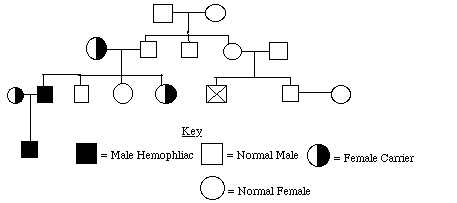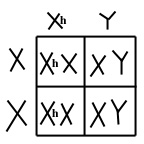http://communityhigh.org/usr/graham/hemophilia/
Genetic
Makeup
Hemophilia is a genetic disease. This means
that the disease is passed down through the generations by means of our
genetic codes, or genes. Humans are made up of 46 chromosomes which have
the battle plans for various functions, actions, and makeup of the body.
These are 23 chromosome pairs. Chromosomes also determine whether or not
we will be male or female. These two chromosomes labeled "x" and "y". A
male will have one "x" and one "y" and females will have two "x"'s. Usually
males are the only ones who get hemophilia. Hemophilia is found on the
"x" chromosome at the very bottom and when it occurs people suffer from
the inability to form firm clots. Which, means in short, that they bleed,
and keep bleeding.
 The reason
that more males get the disease is quite simple. Since the disease
occurs on the "x" chromosome, if a male's "x" chromosome has the disease,
he doesn't have another "x" to block it out. But a female on the other
hand has two "x" chromosomes so if one has the disease, she has another
"x" to block it out. So, if a female has only one "x" diseased she is called
a carrier, so she has the disease in her, but it doesn't show up. A male
is always a hemophiliac.
The reason
that more males get the disease is quite simple. Since the disease
occurs on the "x" chromosome, if a male's "x" chromosome has the disease,
he doesn't have another "x" to block it out. But a female on the other
hand has two "x" chromosomes so if one has the disease, she has another
"x" to block it out. So, if a female has only one "x" diseased she is called
a carrier, so she has the disease in her, but it doesn't show up. A male
is always a hemophiliac.
In reality there are two different kinds of hemophilia
that act alike. Hemophilia A (factor VIII deficiency) and Hemophilia B
(factor IX deficiency) This protein deficiency causes the blood to not
be able to form a firm clot, and thus a hemophiliac who gets bruised or
cut, keeps on bleeding. Not more, but longer. There are also other blood
clotting disorders such as von Willebrand disease which can affects both
sexes.
Generations
One of the most scary and interesting
things about genetic diseases is the fact that they are passed down through
generations of people. They often don't show up for a couple of generations
and then come back in full force. This puzzled many scientists long ago,
but then tools were developed that can map and show how these diseases
are passed down. To understand what is to come, certain things must be
clear. Meiosis is THE crutial part of passing down genetic diseases. Meiosis
is a process by which cells divide and mulitply down until the male's cell
becomes sperm cells, and the female's cell becomes an egg. Also, in the
diagrams below, "xy" means male, and "xx" means female, and if there is
a "h" by it, that chromosome carries the disease. Only a "x" chromosome
will carry hemophilia.
GENERATIONS
The first of the tools scientists use to track
diseases is called a pedigree. A pedigree shows all the males and females
of a family and then shows which person had what. Carriers are marked by
half the shape being filled in, and people which have and show the disease
are completely filled in. People with no signs of the disease what-so-ever,
are not filled in at all. Look at the pedigree below and watch how the
disease moves through the family members.

 Another tool
that scientists use is called a Punnett Square. This shows the possible
outcomes of a child birth between a male and female. If you look
to the left, you see an example of a Punnett Square. The male is on the
top of the square, and has hemophilia because his one "x" chromosome has
the disease. (represented by the small "h") The female is completely clean
from the disease. All of the people represented inside the box are the
possible offspring. In this case, if the couple have a daughter, it will
be a carrier no matter what. (represented by one of the "x"'s having the
disease) If the couple has a son, he will be completely ok no matter what.
Another tool
that scientists use is called a Punnett Square. This shows the possible
outcomes of a child birth between a male and female. If you look
to the left, you see an example of a Punnett Square. The male is on the
top of the square, and has hemophilia because his one "x" chromosome has
the disease. (represented by the small "h") The female is completely clean
from the disease. All of the people represented inside the box are the
possible offspring. In this case, if the couple have a daughter, it will
be a carrier no matter what. (represented by one of the "x"'s having the
disease) If the couple has a son, he will be completely ok no matter what.
 This
picture is another Punnett Square. In this picture the woman is just
a carrier and actually doesn't show any signs of the disease. As you can
see, the result of this birth could be much worse than before. If this
couple had a son, they would have a 50% that their son would have hemophilia.
This is a good example how the disease can hide in the generations of people,
and show up every once in a while in its full blown form.
This
picture is another Punnett Square. In this picture the woman is just
a carrier and actually doesn't show any signs of the disease. As you can
see, the result of this birth could be much worse than before. If this
couple had a son, they would have a 50% that their son would have hemophilia.
This is a good example how the disease can hide in the generations of people,
and show up every once in a while in its full blown form.

 The reason
that more males get the disease is quite simple. Since the disease
occurs on the "x" chromosome, if a male's "x" chromosome has the disease,
he doesn't have another "x" to block it out. But a female on the other
hand has two "x" chromosomes so if one has the disease, she has another
"x" to block it out. So, if a female has only one "x" diseased she is called
a carrier, so she has the disease in her, but it doesn't show up. A male
is always a hemophiliac.
The reason
that more males get the disease is quite simple. Since the disease
occurs on the "x" chromosome, if a male's "x" chromosome has the disease,
he doesn't have another "x" to block it out. But a female on the other
hand has two "x" chromosomes so if one has the disease, she has another
"x" to block it out. So, if a female has only one "x" diseased she is called
a carrier, so she has the disease in her, but it doesn't show up. A male
is always a hemophiliac.

 Another tool
that scientists use is called a Punnett Square. This shows the possible
outcomes of a child birth between a male and female. If you look
to the left, you see an example of a Punnett Square. The male is on the
top of the square, and has hemophilia because his one "x" chromosome has
the disease. (represented by the small "h") The female is completely clean
from the disease. All of the people represented inside the box are the
possible offspring. In this case, if the couple have a daughter, it will
be a carrier no matter what. (represented by one of the "x"'s having the
disease) If the couple has a son, he will be completely ok no matter what.
Another tool
that scientists use is called a Punnett Square. This shows the possible
outcomes of a child birth between a male and female. If you look
to the left, you see an example of a Punnett Square. The male is on the
top of the square, and has hemophilia because his one "x" chromosome has
the disease. (represented by the small "h") The female is completely clean
from the disease. All of the people represented inside the box are the
possible offspring. In this case, if the couple have a daughter, it will
be a carrier no matter what. (represented by one of the "x"'s having the
disease) If the couple has a son, he will be completely ok no matter what.
 This
picture is another Punnett Square. In this picture the woman is just
a carrier and actually doesn't show any signs of the disease. As you can
see, the result of this birth could be much worse than before. If this
couple had a son, they would have a 50% that their son would have hemophilia.
This is a good example how the disease can hide in the generations of people,
and show up every once in a while in its full blown form.
This
picture is another Punnett Square. In this picture the woman is just
a carrier and actually doesn't show any signs of the disease. As you can
see, the result of this birth could be much worse than before. If this
couple had a son, they would have a 50% that their son would have hemophilia.
This is a good example how the disease can hide in the generations of people,
and show up every once in a while in its full blown form.
